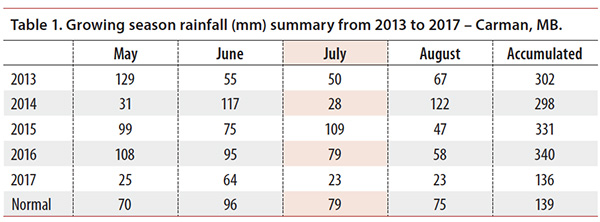Greg Bartley, On-Farm Specialist, MPSG
The decision to spray foliar fungicide weighed heavily on some dry bean farmers in 2017. Below average rainfall and dry conditions leading up to flowering made the risk of a white mould disease outbreak low, yet the thought of the potential damage that a white mould outbreak could incur with the next timely rainfall was hard to ignore.
Coming into the 2018 growing season, the dry conditions are still present and a repeat of the 2017 growing conditions are imminent. If these dry conditions repeat, understanding the risk factors that influence white mould in dry beans will better aid in the decision of whether to spray a foliar fungicide in dry beans.
There are three factors that must be present and interact for a disease to develop. Those three factors are: a susceptible host, a virulent pathogen and favourable environmental conditions. If one of these factors is missing, the disease will not occur.
The two factors that are almost always present are a susceptible host (dry bean) and a virulent pathogen (Sclerotinia sclerotiorum). The factor that has the greatest influence on white mould infection for dry beans in Manitoba is a favourable environment and how the plant canopy influences the microclimate in each field.
The infection process of white mould in dry beans begins when sclerotia germinates to produce small, mushroom-like structures called apothecia. Warm (15 to 25°C), wet soil about ten days before flowering favours the development of apothecia.
Once mature, millions of spores are released from the apothecia. The spores require an external energy source for further development and colonize fallen flower petals.
Secondary infection of healthy plant tissues then occurs within 2–3 days. Once a blossom is infected, the mycelium remains viable for more than a month. This is why the timing of fungicide applications is crucial for prevention of white mould outbreaks. Ensuring proper coverage of flower blossoms helps prevent this disease from developing further and infecting healthy plant tissue.
A dense canopy during flowering may provide an ideal microclimate for white mould development, along with cool maximum daily temperatures (less than 28°C) and lots of moisture from rainfall or high relative humidity. A thick plant canopy will provide a buffer from air temperature, often maintaining the ideal moisture and temperatures for disease development, despite external conditions.
The microclimate below the canopy is influenced by the architecture of the plant and its branching arrangement. Aeration below the plant canopy may be improved by planting more upright genotypes with higher or elevated branches and planting to facilitate more space between plants, either by reducing plant populations or by increasing row widths. Nitrogen fertilizer plays a role by resulting in leafier, bushier plants with more biomass, ultimately creating a denser canopy with reduced aeration.
Manitoba Pulse & Soybean Growers have conducted dry bean fungicide trials since 2013. From 2013 to 2016, a single site near Carman hosted a foliar fungicide product comparison trial in pinto beans. In 2016 and 2017, an additional eight On-Farm Network field trials were established in pinto and navy bean fields across central Manitoba, reaching from Glenboro to Altona.
A single application of fungicide targeted the R2 growth stage (early pin bean) for all trials. Recommended fungicide rates and water volumes were used.
Out of the five years of dry bean fungicide trials, there was a significant yield response to foliar fungicide only two out of the five years (2013 and 2015). Comparing the environmental conditions between the 2013 to 2017 growing seasons, we can reflect on the annual variation in response to foliar fungicide applied to dry beans.

Rainfall is the most variable environmental factor that influences white mould in Manitoba. During flowering, sustained leaf wetness below the canopy is a crucial factor for the disease to develop. The rainfall that coincides with dry bean flowering and foliar fungicide application has the most influence on white mould development.
July is when dry beans begin to flower, and most foliar fungicide applications are applied. Comparing July rainfall from 2013 to 2017, there were two years where the rainfall was considerably below normal, 2014 and 2017 (Table 1). In these years, we did not see a response to foliar fungicide. In 2013, 2015 and 2016, rainfall was either slightly above or below normal. We observed a significant response to foliar fungicide in 2013 and 2015, but not in 2016.
Based on the accumulated rainfall, we anticipated a response to foliar fungicide in 2016. One possible explanation for not seeing a foliar fungicide response in 2016 was the timing of fungicide application. Frequent rainfalls in July made it difficult to apply foliar fungicide by ground at the optimal timing of R2 (early pin bean) due to wet conditions.
In addition to the late timing, a thicker crop canopy could have limited fungicide coverage in the lower canopy. Most fungicide applications did reduce the white mould incidence and severity compared to the untreated control at Carman in 2016, but there was still white mould present in all fungicide treatments. The overall high level of disease pressure likely warranted a second fungicide application to effectively control the disease.
If dry weather conditions continue to repeat themselves in the 2018 growing season, a fungicide application in dry beans may not be warranted.
This work is continuing to better aid farmers with their decisions on foliar fungicide applications in dry beans. Important considerations when assessing your white mould risk are included in the Fungicide Decision Worksheet. To help you assess your field’s risk, the latest weather conditions and weekly summaries for regions in Manitoba may be found here. Incidence of white mould in dry bean varieties evaluated in the MCVET variety trials may be found in MPSG’s Pulse and Soybean Variety Guide.

